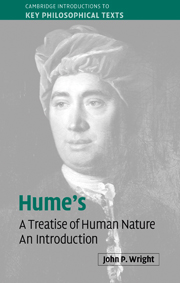Book contents
- Frontmatter
- Contents
- Preface
- Acknowledgments
- List of abbreviations
- 1 The author and the book
- 2 First principles
- 3 Causation
- 4 Skepticism
- 5 Determinism
- 6 Passions, sympathy, and other minds
- 7 Motivation: reason and calm passions
- 8 Moral sense, reason, and moral skepticism
- 9 The foundations of morals
- Bibliography and further reading
- Index
6 - Passions, sympathy, and other minds
Published online by Cambridge University Press: 05 June 2012
- Frontmatter
- Contents
- Preface
- Acknowledgments
- List of abbreviations
- 1 The author and the book
- 2 First principles
- 3 Causation
- 4 Skepticism
- 5 Determinism
- 6 Passions, sympathy, and other minds
- 7 Motivation: reason and calm passions
- 8 Moral sense, reason, and moral skepticism
- 9 The foundations of morals
- Bibliography and further reading
- Index
Summary
At the beginning of Book 2, Hume characterizes passions as secondary impressions which arise from reflection on primary impressions or sensations – or on ideas derived from them (T2.1.1.1: 275; cf. T1.1.2.1: 7–8). Sensations, as Hume analyzes them in Book 1, are of three kinds – impressions of primary qualities, impressions of secondary qualities, and finally “the pains and pleasures, that arise from the application of objects to our bodies” (T1.4.2.12: 192). It is this third kind of sensation, pleasure and pain, which plays a particularly important role in Hume's account of the arousal of the passions. Hume writes that passions “are founded on pain and pleasure, and that in order to produce an affection of any kind, 'tis only requisite to present some good or evil” – that is, some object which causes pleasure or pain (T2.3.9.1: 438). Reflection on such an object is fundamental to Hume's account of the origin of the passions.
Hume divides the passions into those which arise simply from reflection on the pleasure or pain caused by some object, and those which also involve a relation of the object either to oneself or another person. “By direct passions I understand such as arise immediately from good or evil, from pain or pleasure. By indirect such as proceed from the same principles, but by the conjunction of other qualities” (T2.1.1.4: 276). Hume only briefly discusses the first – the “direct passions.”
- Type
- Chapter
- Information
- Hume's 'A Treatise of Human Nature'An Introduction, pp. 190 - 215Publisher: Cambridge University PressPrint publication year: 2009



